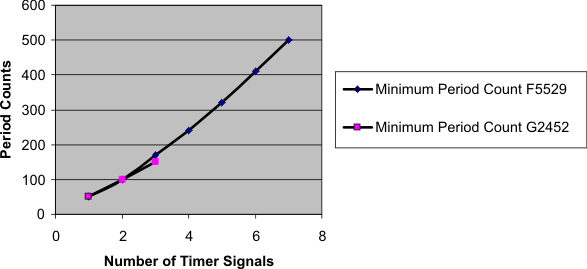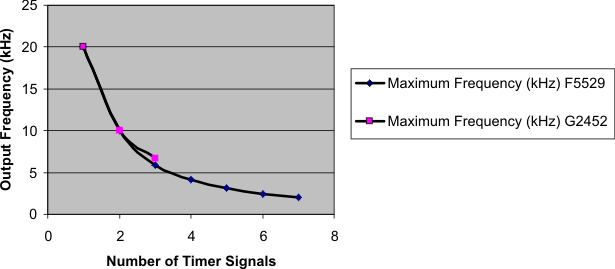SLAA513B December 2011 – February 2022 MSP430G2112 , MSP430G2112 , MSP430G2152 , MSP430G2152 , MSP430G2212 , MSP430G2212 , MSP430G2252 , MSP430G2252 , MSP430G2312 , MSP430G2312 , MSP430G2352 , MSP430G2352 , MSP430G2412 , MSP430G2412 , MSP430G2452 , MSP430G2452
5.2 Maximum Output Frequency vs Number of Signals
The number of output signals being produced has a significant effect on the maximum frequencies that can be reliably produced using continuous mode. This is due to the increase in ISR time when an additional signal must be handled. Figure 5-3 and Figure 5-4 show the relationships between period count and the maximum output frequency produced versus the number of timer signals implemented on the Timer_B module of an MSP430F5529 and from the Timer_A module of an MSP430G2452 sourced from a 1-MHz MCLK. The data is quite similar for both timer modules, so the same values can be used as general guidelines for most MSP430 devices. As shown in Figure 5-1, the Minimum Period Count is independent of MCLK frequency, so the same data can be used as a guideline for any MCLK frequency.


| Number of Timer Signals | MSP430F5529 Timer_B | MSP430G2452 Timer_A | ||
|---|---|---|---|---|
| Minimum Period Count | Maximum Frequency(3) (kHz) |
Minimum Period Count | Maximum Frequency(3) (kHz) |
|
| 1 | 50 | 20 | 50 | 20 |
| 2 | 100 | 10 | 100 | 10 |
| 3 | 170 | 5.882 | 150 | 6.667 |
| 4 | 240 | 4.167 | ||
| 5 | 320 | 3.125 | ||
| 6 | 410 | 2.439 | ||
| 7 | 500 | 2 | ||